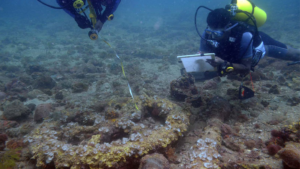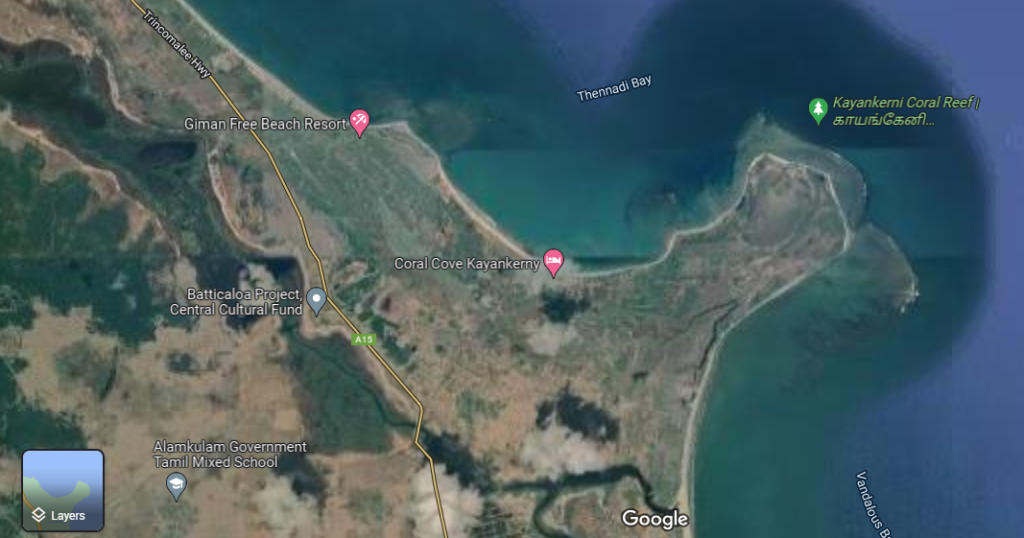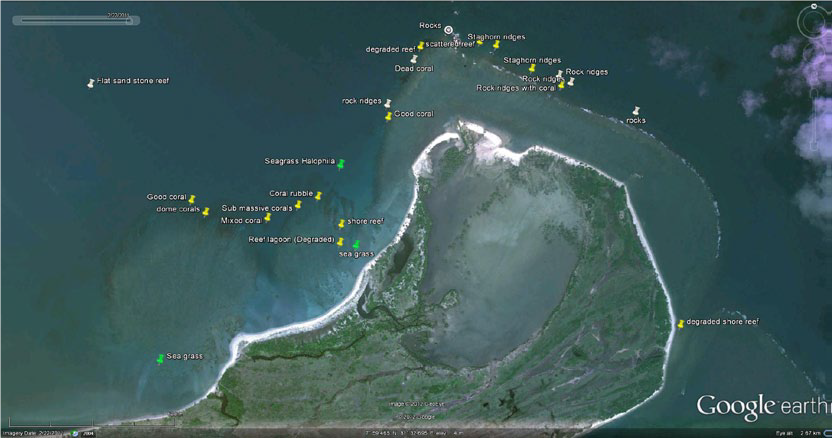Physical Address
23,24,25 & 26, 2nd Floor, Software Technology Park India, Opp: Garware Stadium,MIDC, Chikalthana, Aurangabad, Maharashtra – 431001 India
Physical Address
23,24,25 & 26, 2nd Floor, Software Technology Park India, Opp: Garware Stadium,MIDC, Chikalthana, Aurangabad, Maharashtra – 431001 India

An analysis of coral reef in east Sri Lanka’s Coral reefs at Kayankerny
Coral reefs are among the most diverse ecosystems in the world. A coral reef is a colony of hundreds and thousands of individual animals called coral polyps. These form when free-swimming coral larvae get attached to rocks or other hard surfaces underwater, mainly along the coastlines of islands and continents. A coral reef may grow into a permanent coral island. Often called the “rainforests of the sea.” The exposes that coral reefs are home to a spectacular variety of organisms. According to Coral Reef Alliance, it is the primary habitat for more than 4,000 species of fish, 700 species of coral, and thousands of other plants and animals.
Corals feed either on small marine life such as fish and plankton. They catch their prey using their tentacles attached at the opening, also known as zooxanthellae, found in algae. Corals can be either carnivorous or herbivorous, and their food source gives them the energy to carry out their daily tasks.
According to research, the first coral reefs appeared over 400 -500 million years ago. Although, most corals that currently exist in the world are less than 10,000 years old. According to the UNEP World Conservation Monitoring Center, coral reefs cover about 285,000 km2 or less than 0.1% of the World Ocean’s total surface area. The largest coral reef area (about 92% of the total area) is within the Indo-Pacific region, a region comprising the Pacific, Indian Ocean, Southeast Asia, and the Red Sea.
Top 5 Countries by Coral Reef Area
Rank Country Reef Area (km2) % of world total
1 Indonesia 51,020 17.95%
2 Australia 48,960 17.22%
3 Philippines 25,060 8.81%
4 France 14,280 5.02%
5 Papua New Guinea 13,840 4.87%
Sri Lanka is ranked 52nd in this list with a 680 km2 reef area. This is 0.24% of the world’s total coral reef distribution.
Coral Reefs in Sri Lanka

A majority of Sri Lankan coral reefs are fringing reefs. Fringing reefs are coral reefs that grow in shallow waters. They closely border the coastline or are separated from it by a narrow stretch of water.
Most of the coral reefs are found along the Eastern, Western, and Southern coastlines. Moreover, all the hard and soft corals in Sri Lanka are protected under the Fauna and Flora Protection Ordinance. Coral reefs occur around the Jaffna Peninsula in the North, from Trincomalee to Kalmunai on the East coast, and from Tangalle in the South to Akurala in the Southwest. Coral reefs in the northwest are found from Mannar Island southwards to the Kalpitiya Peninsula. Over 180 hard coral reef species and 900 species of reef-associated fish were recorded island-wide in the coral reefs. Around 70% of total marine fish production comes from coastal waters and reef habitats (NARA 1998). Reef-based tourism is an important income source in Sri Lanka. Coral reefs also provide protection from storms and coastal erosion in many parts of the country.
In this article, we will discuss about an important coral reef Kayankerny on the eastern coast of Sri Lanka.
Kayankerny Reef

Kayankerni Coral Reef is a Nature Reserve located in Kayankerni. It is one of the 221 Nature Reserves in Sri Lanka. Kayankerni reef is located North of Pasikudah on the East coast of Sri Lanka. It is 47 kilometers North of Batticaloa city. fringing coral reefs are found along most of the coastline including Pasikudah Bay and Kalkuda. Many of these nearshore reefs are now in a degraded condition. In contrast, Kayankerni reef remains healthy and has suffered minimal impact from recent coral bleaching events and constitutes an important refuge for coral reef biodiversity on the East coast. Kayankerni is home to a high diversity and abundance of marine life, including 207 species of fish observed up to date.
Kayankerni is also particularly important due to the historic shipwreck sites adjacent to the reef. ‘The British Sergeant’, a merchant vessel that sank after coming under fire when it altered its course to help a carrier in 1942, and SS Lady McCallum, a cargo ship that ran aground in 1926, are located off the Kayankerni Reef.

The kayankerny reef area contain three type of coral areas. fringing reef system around Elephant Point, a nearshore patch reef off Kayankerni located approximately 2km from the shoreline, and a coastal fringing reef along the shoreline, located parallel to the patch reef. The reef extends from Thennadi Bay, Vandalous Bay, which is the main bay, the Elephant Point Bay towards Kalkudah Bay and spreads 800 metres from the coast.
extensive coral areas are located around 1-2km off the coast. The fringing reef around Elephant Point (ELE) and the patch reef (KYK) were selected for long term monitoring. ELE consists of a nearshore fringing reef with a clearly defined reef lagoon, shallow reef crest and outer reef slope. KYK is a patch reef with a shallow sandy area in the middle.
Biodiversity from Kayankerny
There have been 18 species of Butterflyfish documented on the reef, which could be seen in crystal clear water. Some examples of Butterflyfish are the Chaetodon species and of them, Chaetodon collaris, Chaetodon cittrinellus, Chaetodon falcula, Chaetodon xanthocephalus.
These are very prominent and colorful butterfly fish. They live only within the backdrop of healthy corals and are often referred to as Bio Indicators. The more that these species are present in these habitats indicates the biodiversity of the habitat. The diversity of their colors attracts tourists. They feed on coral polyps and form their own territories.
Marine species recorded at the site indicate a highly diverse population. Based on the limited sampling carried out, the team documented 9 spp. Algae, 3 spp. Seagrasses, 115 Invertebrate species, including 51 coral species and 206 fish species, and a single species of sea turtle within the limited surveys carried out at the Kayankerni reef.
Other notable omissions included top-end predators, including Trevallys (Carangidae spp.), Barrakuda (Sphyraenidae spp.), and Large Groupers (Serranidae spp.). Medium to small-sized groupers was common on the reef, including E. caeruleopunctatus, C.argus, C.formosa. Moreover, Angel fishes were abundant with common large species (Pomacanthus semicirculatus, P. imparator) observed along with Centropyge multi spins, C. flavissimus, and C. eiblii present.
Few crustaceans were observed primarily due to the limitations in the preliminary survey observations. Several Painted Spiny lobsters of medium size were observed along with good numbers of Sea cumbers still populating reef areas. The Big Blue Octopus, Reef Squids, Pharaoh cuttlefish, Large Spider conch shells (Lambis spp.), and large ear shells (Pinna spp.) were notable among the mollusks. No Giant clam (Tridachna) shells were observed. An omission that may be directly attributed to the Marine Aquarium trade collection.
How climate change is impacting coral reefs in Kayankerny
Climate change is the greatest global threat to coral reef ecosystems. Scientific evidence now clearly indicates that the Earth’s atmosphere and ocean are warming and that these changes are primarily due to greenhouse gases derived from human activities.
As temperatures rise, coral bleaching events occur.
When water is too warm, corals will expel the algae living in their tissues, causing the coral to turn completely white. This process called coral bleaching. In kayankerny nearly 60% of all live corals were bleached. Reef was significantly impacted by the 2016 coral bleaching event. A spike of 1–2°C in ocean temperatures sustained over several weeks can lead to bleaching, turning corals white. In 2016 in the bleaching period, Water temperature during this period ranged from 30-33o C, which can be considered to be above the normal range of 28-29o C.
Increased greenhouse gases from human activities result in climate change and ocean acidification. The world’s ocean is a massive sink that absorbs carbon dioxide (CO2). Also, the ocean absorbs approximately one-third of the atmosphere’s excess carbon dioxide, resulting in a more acidic ocean. Although this has slowed global warming, it is also changing ocean chemistry. Ocean acidification slows the rate at which coral reefs generate calcium carbonate, thus slowing the growth of coral skeletons.

Sea level rise, may lead to increase in sedimentation for reefs located near land-based sources of sediment. Sedimentation runoff can lead to the smothering of coral. Potentially interfere with photosynthesis, feeding, recruitment, and other key physiological reef processes. For example, it can cause increased sedimentation due to shoreline erosion which could smother reefs or reduce sunlight needed for photosynthesis. Even small increases in sea level can increase turbidity on fringing reefs.
Other than above climate changing factor there are human impacts on kayankerny
Export driven fisheries for groupers, snappers, parrotfish and other reef fish can have impacts on the populations of these species. Some fishing methods can also cause damage to coral reefs. Primarily among them are bottom-set nets that result in the entanglement and damage of corals. Although not practiced within the MPA, illegal fishing using explosives is a major problem outside the MPA and can have major impacts on fish populations and habitats.
Valachchenai lagoon is the primary drainage point for the Maduru Oya river basin. Maduru Oya spans a length of 135km and has been extensively altered for irrigating the eastern plains for rice cultivation. There is also significant agriculture, including rice cultivation, in coastal areas around Kayankerni. Currently, there is no water quality monitoring around the coral reef and a poor understanding of the impacts of agricultural practices on the coral reef. However, excessive fertilizers and pesticides are likely to impact nearshore coral reefs.
Several organizations are working towards conserving these reefs with great success stories.
The conservation projects on Kayankerny
ORCA – Dilmah Conservation Reef Surveys
(With Inputs from Dinesh Balasri )